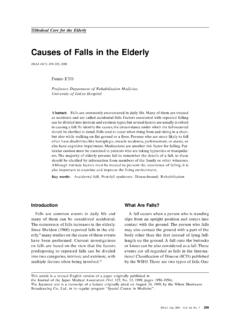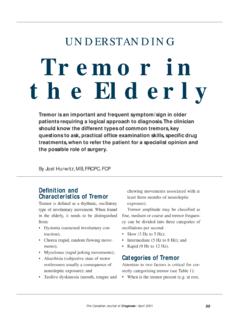Transcription of Psychopharmacology in Children & Adolescents
1 Psychopharmacology in Children & Adolescents Susan Sharp, Department of Psychiatry and Behavioral Sciences Kansas University Medical Center Treating Children and Adolescents Diagnostic hypothesis guides intervention Pay careful attention to any comorbidity and differential diagnosis z Especially any associated learning disorder or cognitive deficit Pharmacotherapy is only part of the treatment plan z Therapies, parental counseling and education, accommodations at school Treating Children and Adolescents Family and child must be aware of risks, benefits, possible side effects or adverse events, and any alternative treatments Start low and go slow After sufficient period of stabilization (often 6-12 months) may evaluate need for continued treatment Still need more data on efficacy and safety of medications in Children Major Classes of Drugs Used Stimulants Antidepressants Antipsychotics Mood stabilizers Others Stimulants Use- First class of drugs reported to be effective in treatment of behavioral disturbances in Children with ADHD.
2 Mechanism of action-Enhance dopamine and norepinephrine by blocking reuptake and sometimes increasing release Medications z Short acting and long acting forms Stimulants Shorter Acting Methylphenidate (Ritalin, Focalin, Methylin). z Total daily dose ranges from z Dose bid or tid, usually lasts 4 hours Detroamphetamine (Dexedrine). z Total daily dose ranges from z Dose bid-tid, lasts approx. 6 hours Mixed amphetamine salts (Adderall). z Total daily dose ranges from z Dose once daily to bid, lasts 4-6 hours Stimulants Longer Acting Methylphenidate products (Concerta, Metadate CD, Ritalin LA, Focalin XR). z Last 10-12 hours Mixed Amphetamine Salts (Adderall XR). z Lasts 10-12 hours Stimulants Side Effects Insomnia Decreased appetite Weight loss Stomachache Rebound effects (usually with short acting). Moodiness/ irritability/ crying Increased anxiety Increases in heart rate/blood pressure Increased lethargy Tics? Stimulants Warnings Avoid in Children with heart murmurs or structural cardiac abnormalities or other serious heart problems z Antidepressants SSRIs Use- Depression and Anxiety disorders Mechanism of action- Block reuptake of serotonin Examples- Prozac, Zoloft, Celexa, Lexapro, Paxil, Luvox Side effects- Agitation, gastrointestinal symptoms, irritability, insomnia, sexual dysfunction.
3 Watch for drug interactions in Prozac, Paxil, and Luvox. Antidepressants Atypical antidepressants z Use- anxiety, depression, ADHD. z Mechanism of action- affect the release and reuptake of brain neurotransmitters including serotonin, norepinephrine, and dopamine. z Examples- Wellbutrin, Remeron, Effexor z Side effects- activation, sedation, weight gain depending on medicine Antidepressants Tricyclic antidepressants z Use- ADHD, Enuresis, OCD. z Mechanism of action- increase serotonin and norepinephrine z Examples- Amitriptyline (Elavil), Clomipramine, Imipramine, Nortriptyline z Side effects- dry mouth, constipation, sedation. Must follow levels and monitor EKGs baseline and during treatment. Watch for drug interactions. Lethal in overdose. Antidepressants Warnings- Risk of Suicidal Ideation z October 2004, FDA issued statement for antidepressants to revise their labeling to include a boxed warning and expanded warning statements about the increased risk of suicidality in Children and Adolescents being treated with antidepressants z Antipsychotics Novel Atypical Antipsychotics z Use- Psychosis, mania, aggression, self- injurious behaviors in Children with mental retardation and pervasive developmental disorders, Tourette's z Mechanism of action- block specific dopamine and serotonin neurotransmitters (except Abilify).
4 Z Examples- Risperdal, Seroquel, Zyprexa, Geodon, Abilify Antipsychotics Novel Atypical Antipsychotics cont. z Side Effects- drowsiness, increased appetite, weight gain, insomnia, extrapyramidal effects- dystonias, restlessness, parkinsonism, possible increases in QTc interval on EKG. Antipsychotics Typical antipsychotics z Uses- same as atypicals z Mechanism of action- Dopamine antagonists z Examples- Haldol, Prolixin, Orap z Side effects- Some more likely to cause extrapyramidal side effects Mood Stabilizers Lithium z Use- For bipolar disorder and can augment treatment for depression z Exact mechanism of action unknown z Side effects- nausea/vomiting, polyuria, polydipsia, tremor, sedation, weight gain, acne, decreased thyroid function z Monitoring- blood levels, kidney, thyroid functions Mood Stabilizers Lithium cont. z Avoid giving with NSAIDs, and certain diuretics which can increase lithium levels. Mood Stabilizers Valproic Acid (Depakote).
5 Z Use- Bipolar disorder, aggression, anticonvulsant z Side effects- sedation, nausea, thinning of hair, weight gain, bone marrow suppression, liver toxicity (both rare), teratogenic z Monitor- levels, liver function tests, blood counts, renal function Mood Stabilizers Tegretol z Use- Bipolar disorder z Side effects- dizziness, sedation, nausea, bone marrow suppression, liver toxicity, skin disorders (including Stevens-Johnson syndrome), teratogenic z Monitor levels, liver function tests, blood counts, renal function Mood Stabilizers Trileptal z Use- Bipolar disorder but limited data z Similar structure to tegretol, but does not require the same blood monitoring z Side effects- Dizziness, headache, sedation, nausea, hyponatremia Mood Stabilizers Lamictal z Use- Bipolar disorder, need more studies z Anticonvulsant z Side effects- Dizziness, sedation, headache, nausea, lack of coordination, insomnia, rash (Steven's Johnson Syndrome).
6 Other Medications Alpha-Adrenergic Agonists z Uses- ADHD, aggression, Tourette's z Mechanism of action- Stimulates alpha 2- adrenoreceptors in brainstem, thus activating an inhibitory neuron, resulting in decreased sympathetic outflow z Examples- Clonidine, Tenex z May give once, twice, or three times/day z Side effects- sedation, hypotension, dry mouth, depression Other Medications Strattera z Uses- ADHD. z Mechanism of action- Norepinephrine reuptake inhibitor z Doses- mg/kg/day z Side effects- Sedation, mild appetite suppression z Monitor for evidence of liver injury Conclusion Consider pharmacotherapy as part of a broader treatment plan Assess potential risks, benefits, side effects, and alternatives Identify target symptoms and carefully monitor progress Have realistic expectations Research







